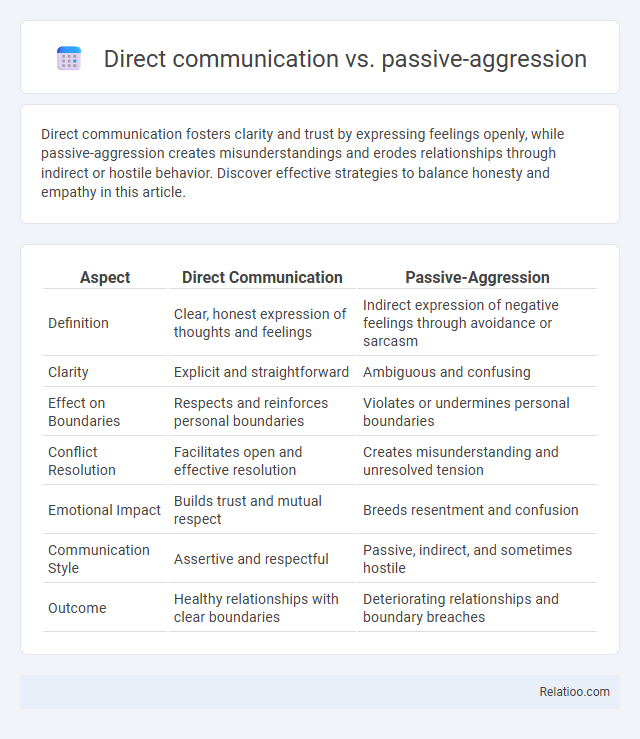Direct communication fosters clarity and trust by expressing feelings openly, while passive-aggression creates misunderstandings and erodes relationships through indirect or hostile behavior. Discover effective strategies to balance honesty and empathy in this article.
Table of Comparison
| Aspect | Direct Communication | Passive-Aggression |
|---|---|---|
| Definition | Clear, honest expression of thoughts and feelings | Indirect expression of negative feelings through avoidance or sarcasm |
| Clarity | Explicit and straightforward | Ambiguous and confusing |
| Effect on Boundaries | Respects and reinforces personal boundaries | Violates or undermines personal boundaries |
| Conflict Resolution | Facilitates open and effective resolution | Creates misunderstanding and unresolved tension |
| Emotional Impact | Builds trust and mutual respect | Breeds resentment and confusion |
| Communication Style | Assertive and respectful | Passive, indirect, and sometimes hostile |
| Outcome | Healthy relationships with clear boundaries | Deteriorating relationships and boundary breaches |
Understanding Direct Communication: Definition and Benefits
Direct communication involves expressing your thoughts, feelings, and needs clearly and respectfully, fostering transparency and reducing misunderstandings. This communication style enhances trust, improves relationships, and promotes efficient problem-solving by encouraging openness. Choosing direct communication over passive-aggression ensures your message is understood correctly, preventing confusion and unresolved conflicts.
What is Passive-Aggression? Key Traits and Examples
Passive-aggression is a behavioral pattern characterized by indirect resistance to demands or requests, often expressed through procrastination, stubbornness, or deliberate inefficiency. Key traits include sarcasm, sulking, avoiding direct confrontation, and displaying resentment covertly rather than openly addressing issues. Examples of passive-aggressive behavior include giving someone the silent treatment, making backhanded compliments, or intentionally missing deadlines to express dissatisfaction without verbal conflict.
Direct Communication vs Passive-Aggression: Core Differences
Direct communication involves clear, straightforward expression of thoughts and feelings, promoting transparency and reducing misunderstandings. Passive-aggression, in contrast, conveys negative emotions indirectly through subtle behaviors like sarcasm, procrastination, or backhanded compliments, often fostering confusion and conflict. Understanding these core differences helps improve interpersonal relationships by encouraging honesty and reducing covert hostility.
The Psychological Impact of Direct Communication
Direct communication fosters clarity and emotional honesty, reducing misunderstandings and building trust in relationships. It allows Your emotions to be expressed openly, which can promote psychological well-being and reduce stress associated with hidden feelings. Contrasting with passive-aggression, which often leads to confusion and resentment, direct communication supports healthier mental states and more effective conflict resolution.
Emotional Consequences of Passive-Aggressive Behavior
Passive-aggressive behavior often leads to confusion, mistrust, and emotional distress in relationships, as it obscures true feelings and intentions. Your emotional well-being can suffer due to unresolved conflicts and the constant tension created by indirect expressions of anger or resentment. In contrast, direct communication promotes clarity and trust by openly addressing issues and fostering healthier emotional connections.
How Direct Communication Improves Relationships
Direct communication fosters trust and clarity by encouraging honest expression of feelings and needs, which reduces misunderstandings and conflicts in relationships. Passive-aggression often creates confusion and resentment, as unspoken frustrations build over time, undermining connection and emotional safety. By choosing direct communication, you promote healthier interactions and strengthen your bonds with others through transparency and mutual respect.
Common Signs of Passive-Aggression in Daily Life
Common signs of passive-aggression in daily life include subtle behaviors like procrastination, sarcasm, and intentional inefficiency that mask discontent. You might notice indirect resistance, such as giving the silent treatment or making ambiguous statements that hinder clear communication. Recognizing these signs helps in addressing conflicts more effectively compared to direct communication or overt confrontation.
Barriers to Practicing Direct Communication
Barriers to practicing direct communication often include fear of conflict, lack of confidence, and cultural norms that discourage openness, leading individuals to resort to passive-aggression as a coping mechanism. Passive-aggression manifests through indirect expressions of hostility, such as sarcasm or silent treatment, which obstructs clear and honest dialogue essential for effective relationships. Overcoming these barriers requires cultivating emotional intelligence and communication skills to foster transparency and reduce misunderstandings created by passive-aggressive behaviors.
Strategies to Shift from Passive-Aggressive to Direct Interaction
Shifting from passive-aggressive behavior to direct communication improves clarity and strengthens relationships by encouraging honest expression of feelings and needs. You can adopt strategies such as practicing self-awareness, using "I" statements to express emotions without blame, and seeking feedback to ensure your message is understood. Consistent application of these techniques fosters trust and reduces misunderstandings, creating a healthier interaction dynamic.
Cultivating a Culture of Open and Direct Dialogue
Cultivating a culture of open and direct dialogue emphasizes clear expression of thoughts and feelings, reducing misunderstandings and fostering trust within teams. Passive-aggression undermines this by masking true emotions with indirect remarks, leading to confusion and eroded relationships. Prioritizing direct communication strategies enhances collaboration, accountability, and overall organizational health.

Infographic: Direct communication vs Passive-aggression
 relatioo.com
relatioo.com